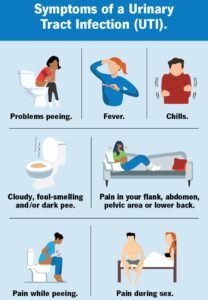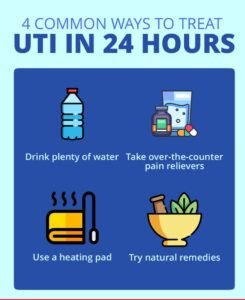Urinary tract infections (UTIs) manifest as an infectious condition impacting various segments of the urinary system, encompassing the kidneys, ureters, bladder, and urethra. Predominantly, UTIs stem from the infiltration of bacteria through the urethra into the urinary tract. Symptoms may diverge depending on the specific area of the urinary tract affected. Common indicators encompass discomfort or a burning sensation during urination, frequent urges to urinate, the presence of blood in urine, and pelvic or back discomfort. Notably, UTIs exhibit a higher incidence among women, attributable to anatomical variances that render the urinary tract more susceptible to bacterial intrusion. The standard course of treatment typically involves antibiotics, with utmost importance placed on completing the entire prescribed regimen to ensure thorough eradication of the infection and mitigate the risk of fostering antibiotic resistance.
Indications of Urinary Tract Infections
Urinary tract infections (UTIs) typically present with a range of symptoms, which may include: 1

- Sensation of burning during urination
- Persistent or heightened urgency to urinate, often with minimal urine output
- Urine that appears cloudy, dark, bloody, or emits an unusual odor
- Feelings of fatigue or shakiness
- Discomfort localized in the pelvic region or back
- Pain experienced in the penis or rectum among males
- Instances of mental confusion, particularly observed in older individuals
- Occasional bedwetting, observed in both children and older adults
- In cases where the infection extends to the kidneys, additional symptoms may manifest, such as fever, chills, nausea, vomiting, and pain in the upper back or side.
Causes of UTIs
Urinary tract infections (UTIs) typically stem from the invasion of bacteria into the urinary system, often originating from the gastrointestinal tract or skin. While Escherichia coli (E. coli) stands as the primary culprit, various other bacteria can also incite these infections. UTIs arise when bacteria infiltrate the urethra and subsequently infect diverse segments of the urinary system, such as the bladder, urethra, or kidneys.
Various factors increase the likelihood of urinary tract infections (UTIs), such as differences in female anatomy (like a shorter urethra), sexual activity, changes in vaginal bacteria, pregnancy, age (both older adults and young children), urinary tract abnormalities, poor hygiene habits, and conditions that block the urinary tract. Additionally, factors like a compromised immune system, insufficient fluid intake, and inadequate genital hygiene contribute to UTIs. Proactive measures to diminish UTI risk involve adequate hydration, urination post-sexual activity, adherence to stringent hygiene protocols, and prompt treatment of symptoms to forestall the spread of infection to other urinary tract regions.
Read also: PHYSICAL FITNESS: A PATH TO WELLNESS
Can sperm cause urinary tract infections?
No, the presence of sperm itself does not contribute to urinary tract infections (UTIs) in women. UTIs primarily occur due to bacterial infiltration into the urinary system, with Escherichia coli (E. coli) being a prevalent instigator in approximately 90% of cases. Although sperm and urine traverse the same pathway, the risk of UTIs hinges on bacterial contamination during sexual activity rather than the mere presence of sperm. Adherence to proper hygiene protocols, such as urinating both before and after intercourse, plays a pivotal role in mitigating the risk of bacterial contamination and subsequent UTIs. It’s essential to emphasize that UTIs are not classified as sexually transmitted infections, and individuals cannot transmit a UTI to their partners during sexual intercourse. 2
Managing Urinary Tract Infections: Effective Approaches
Urinary tract infections (UTIs) are commonly treated with antibiotics prescribed by a healthcare professional. It’s vital to adhere to the antibiotic regimen diligently, even if symptoms improve early, to avoid recurrence and increased difficulty in treatment. For uncomplicated cases in healthy individuals, a 1- to 3-day antibiotic course might suffice, depending on symptoms and medical history. Severe UTIs, especially those requiring hospitalization, may necessitate intravenous antibiotics. Healthcare providers may also suggest extended low-dose antibiotic use, supervised self-treatment, or post-coital antibiotics for UTIs linked to sexual activity. Additional preventive measures include staying hydrated, urinating after intercourse, wiping correctly, and avoiding irritating feminine products. Prompt medical attention is crucial to prevent complications like kidney damage, sepsis, or recurrent infections.
Natural remedies
Natural remedies for urinary tract infections (UTIs) encompass a range of home-based solutions and lifestyle adjustments aimed at easing symptoms and aiding the body’s recovery process. Here are several effective natural approaches drawn from reputable sources:

- Hydration is key. Maintaining adequate fluid intake, including water and water-rich foods, assists in flushing out harmful bacteria from the urinary system.
- Boost Vitamin C Consumption: Incorporating Vitamin C into the diet can bolster the immune system, potentially warding off UTIs.
- Harness the Power of Cranberries: Cranberry juice or supplements may hinder bacterial adherence to the urinary tract, potentially thwarting UTIs.
- Integrate Probiotics: Probiotic supplements aid in replenishing beneficial gut bacteria, which in turn helps prevent harmful bacteria from adhering to urinary tract cells.
- Prioritize Rest and Recovery: Allowing the body ample time to heal is crucial, as some UTIs can resolve naturally over time without the need for antibiotics.
- Symptom Management: Employing strategies such as using a heating pad, opting for over-the-counter pain relievers, and maintaining regular urination patterns can effectively alleviate UTI symptoms at home.
It’s important to recognize that, while these natural interventions can be beneficial, severe or recurrent UTIs may necessitate antibiotic therapy. If symptoms persist or worsen, seeking prompt medical attention from a healthcare professional is essential to ensure proper diagnosis and treatment, thereby minimizing the risk of complications.
Managing UTI with Medications
Treating UTI typically involves prescribing antibiotics tailored to the specific bacteria causing the infection. The selection of antibiotics and treatment duration hinges on factors such as the severity of the infection, potential complications, and the patient’s overall health. Common antibiotics for UTIs include:3
- Ceftriaxone
- Cephalexin
- Doxycycline
- Fosfomycin (Monurol)
- Nitrofurantoin (Macrobid, Macrodantin, and Furadantin)
- Trimethoprim and sulfamethoxazole (Bactrim, Bactrim DS)
For simple urinary tract infections, common treatments like trimethoprim-sulfamethoxazole and trimethoprim are usually effective. Shorter treatment durations of just 3 days show similar rates of getting rid of the infection and fewer side effects when compared to longer treatments. In cases of recurrent UTIs, healthcare providers may suggest continuous low-dose antibiotic prophylaxis or patient-initiated therapy to prevent infections. Completing the full antibiotic course as prescribed is essential to ensuring complete clearance of the infection and decreasing the likelihood of recurrence. Seek advice from a healthcare professional regarding the most suitable medication, dosage, and treatment duration.
How can Utis be prevented?
Preventing urinary tract infections (UTIs) involves adopting various strategies and lifestyle adjustments. The following are effective methods to prevent UTIs, as supported by reputable sources:

- Maintain Adequate Hydration: Consuming ample fluids, particularly water, aids in flushing bacteria out of the bladder and urinary tract, thereby diminishing UTI risk.
- Urinate Pre- and Post-Intercourse: Emptying the bladder before and after sexual activity facilitates the elimination of bacteria that might have entered the urinary tract during intercourse.
- Embrace Proper Hygiene Practices: Employing the front-to-back wiping technique after using the restroom helps thwart the transfer of bacteria from the anal region to the urethra, thus lowering UTI susceptibility.
- Avoid Irritant Products: Eschew the usage of douches, deodorant sprays, scented powders, and similar feminine products that could disrupt the natural bacterial balance, heightening UTI risk.
- Consider Probiotic Consumption: Integrating probiotic-rich foods or supplements into your diet promotes a healthy bacterial balance in the urinary tract, potentially reducing UTI occurrence.
- Regularly Empty Your Bladder: Ensuring regular bladder emptying prevents urine buildup, which creates a conducive environment for bacterial growth.
- Explore Cranberry Supplements: While scientific evidence regarding the effectiveness of cranberry supplements in UTI prevention remains inconclusive, some studies suggest their potential benefit in inhibiting bacteria adherence to the bladder wall.
- Practice Sound Sexual Hygiene: Incorporating practices such as urination before and after intercourse aids in flushing out bacteria, diminishing UTI risk.
By integrating these preventive measures into your daily regimen, you can significantly mitigate the chances of experiencing a urinary tract infection.
